“Future of Life” Creator’s Voice Vol. 9, Spotlight on MATSUI Tatsuya / HIROKAWA Tamae “Life 1000 Years in the Future: Mahoroba” Androids Designer / Android Costumes Designer
Flower Robotics, Inc.
MATSUI Tatsuya
SOMA DESIGN
HIROKAWA Tamae
Current job responsibilities
Matsui:
I design robots and create contemporary art.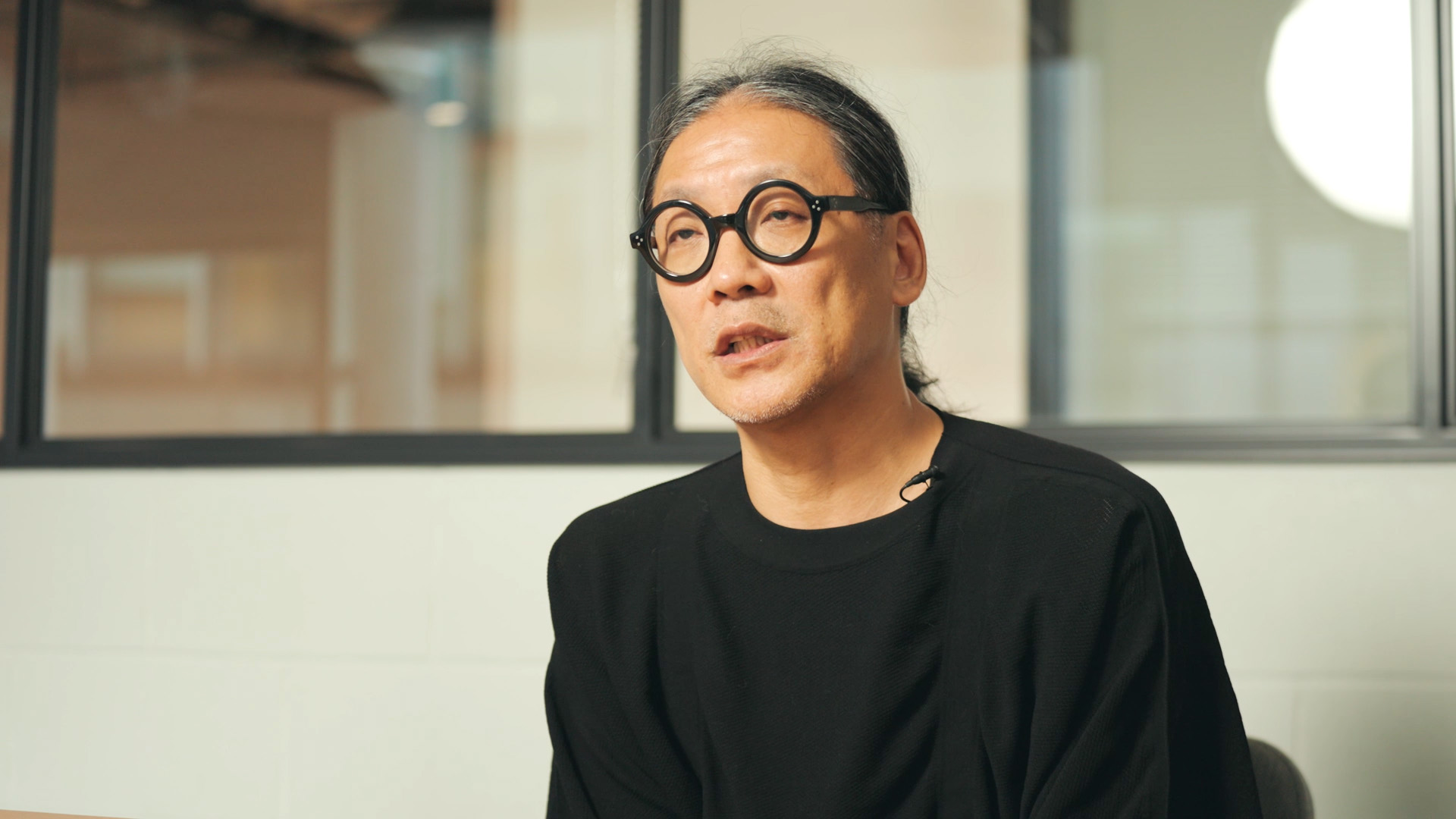
Hirokawa:
I approach clothing design from the perspective that garments are like a second skin. In addition to designing for SOMARTA, my fashion brand, I apply fashion techniques to fields beyond clothing through my creative studio, SOMA DESIGN.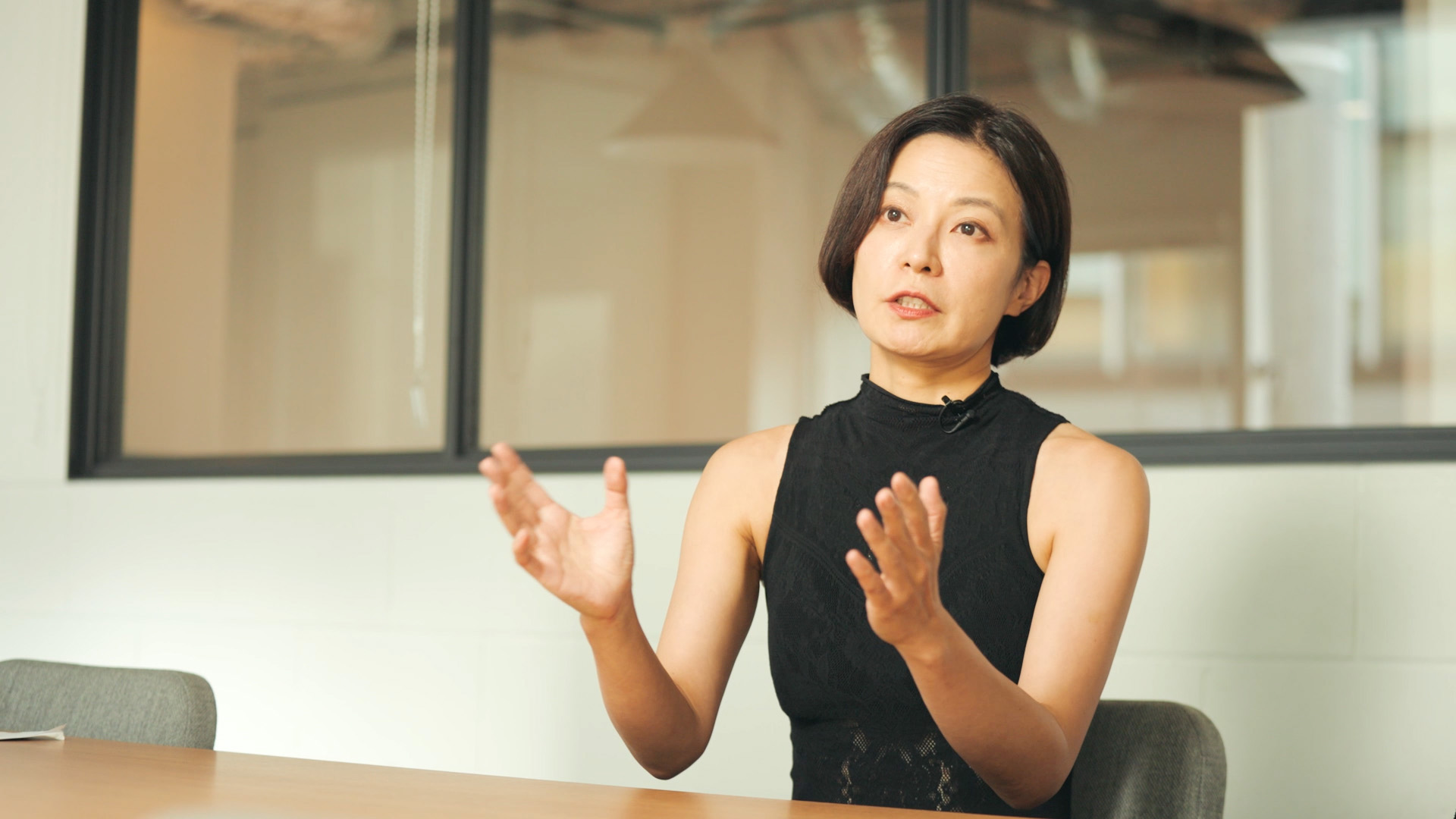
Role in Future of Life
Matsui:
I was in charge of designing the robots featured in the Pavilion and shaping the worldbuilding for Zone 3, “Life 1000 Years in the Future: Mahoroba.” With Professor ISHIGURO Hiroshi and the other creators, I explored the worldbuilding of Zone 3, including the question of why it should be 1000 years in the future. Based on that, I developed the core concept for the external design of MOMO, the android that represents humanity 1000 years from now.
Hirokawa:
I was responsible for designing the costume worn by MOMO, the android featured in Zone 3.
Feelings on the Pavilion, the exhibits, and the product concept
Matsui:
Unlike my usual robot design work, the context of the Expo required me to envision robots and androids 50 or even 1000 years into the future, and I had to work with Professor Ishiguro and others to consider what role robots and androids should play in such a future world. As a result, I felt inspired to attempt a kind of creative process that I wouldn’t normally get to pursue, one that really pushes the boundaries of imagination.
Hirokawa:
Professor Ishiguro’s bold and lucid vision was eye-opening and profoundly inspiring for me: He believes that technology will someday supplement human physical abilities, that robots and humans will eventually coexist, that the boundaries between human life and robotic life will dissolve, and that robots will become transcendent beings whose knowledge surpasses that of human. He also shared his hope that the Pavilion would convey how humans can be liberated from their physical bodies to achieve true mental freedom. Translating that vision into tangible form felt like an enormous challenge.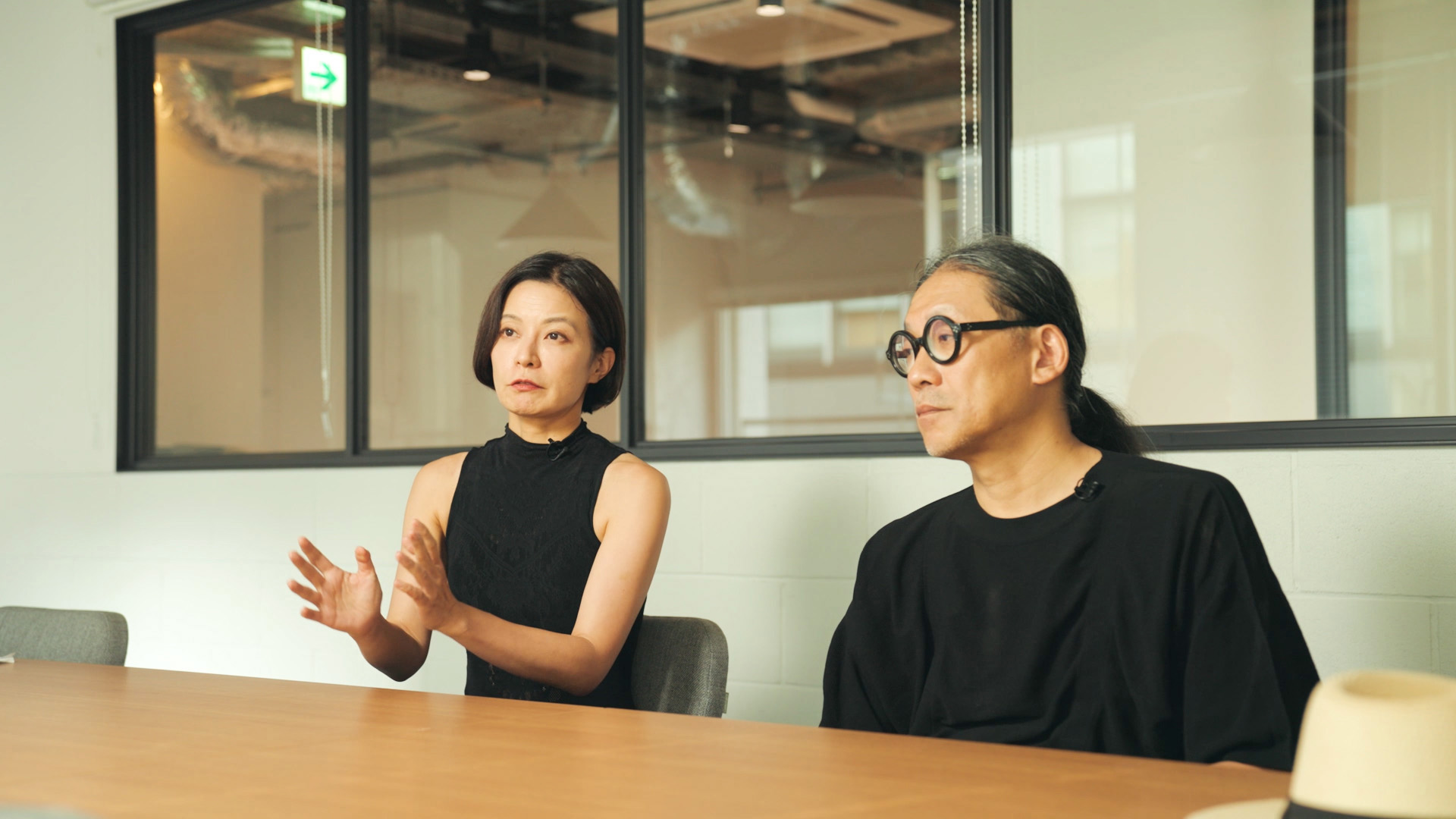
Memorable words from Producer ISHIGURO Hiroshi
Matsui:
As Hirokawa-san mentioned earlier, I sensed that Professor Ishiguro regarded freedom as a central theme. Translating that into physical and technical expressions using the materials available to us as designers—that part felt quite challenging.
Hirokawa:
During our discussions with Professor Ishiguro and the other creators about the future blurring of boundaries between humans and robots, he noted that, no matter how much of a person’s body is augmented with mechanical components—such as prosthetic arms and legs—their individuality remains intact. That philosophy resonates with the project’s core theme of the Amplification of Lives, and I feel that it fundamentally redefines our understanding of what ‘life’ means today.
Commitments, challenges, and innovations
Matsui:
For Zone 3, I first considered how we might depict the world 1000 years from now, not solely through androids, but through a larger narrative. When imagining where androids might gather in Japan 1000 years in the future, Mount Yoshino in Nara, which is famous for its cherry blossoms, came to mind. Even if the planet or cities have transformed drastically, I believe that places like Yoshino, which have already endured for over a thousand years, will still remain. I shared with the other creators the idea of androids gathering in Yoshino in spring to enjoy cherry blossom viewing.
Next, I considered the androids’ color. The initial android prototype shown to me by Professor Ishiguro was jet black. But since the Expo is a space visited by children as well, I felt that it might make too strong an impression and that a gentler color was needed. Skin tone is an incredibly delicate matter, so I struggled with this. Whether we chose an existing human skin tone or an artificial one, any choice risked cultural misinterpretation or criticism. Then I thought, what if we use a soft peach tone, inspired by cherry blossoms, something that might naturally soften people’s expressions? I started researching peaches and learned that they symbolize immortality in many cultures and often relate to themes of life, so it felt like the perfect choice. I shared the idea with Hirokawa-san, and eventually presented it to Professor Ishiguro, and the idea gained a consensus. The androids on which we were to implement that concept originally had a much more exposed, mechanical look. But technology 1000 years from now wouldn’t look like that, so we decided to cover the entire body in silicone. The engineers warned us it might impair movement, but I persuaded them to fully encase the body in silicones nonetheless. And Hirokawa-san made great efforts to achieve that soft peach color for the silicone.
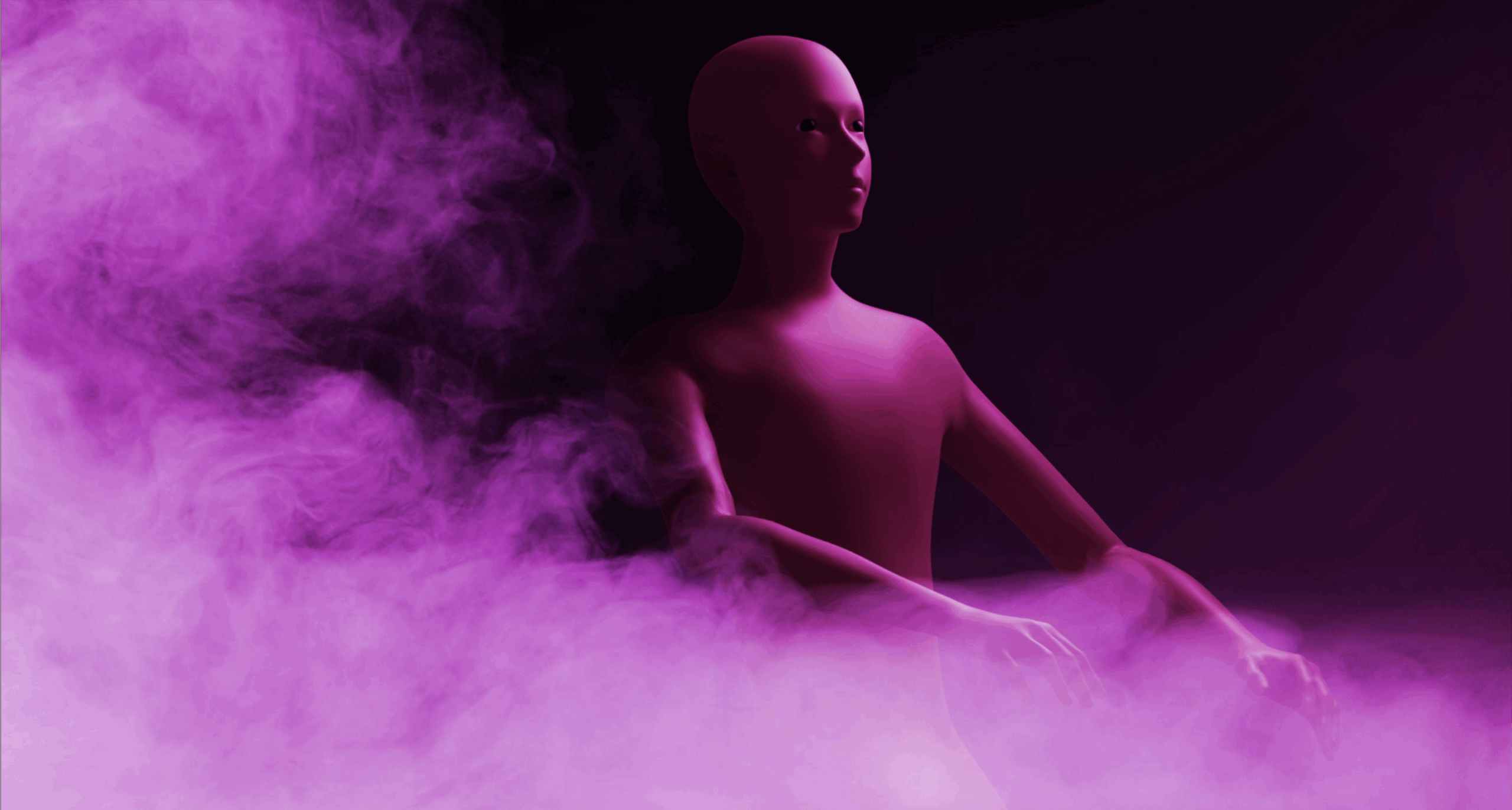
Hirokawa:
For the costumes of the androids envisioned 1000 years in the future, as seen in Zone 3, I approached the designbased on two conceptual directions. The first was androids as an evolved form of humans, and. the second was androids as descendants of dolls.
For the androids as evolved humans, I envisioned them as standing at the apex of a long chain of life—from primitive organisms, evolving in the sea, and across countless evolutionary branches, ultimately arriving at the modern human form. The androids in Zone 3 represent the ultimate form to emerge from that continuum.
For the androids as descendants of dolls, I drew on the Japanese belief that life dwells in dolls, a worldview rooted in our tradition of prayer. Tracing this lineage back to the *dogu* clay figures of the Jomon period [ca. 14,000 BCE to ca. 300 CE], I saw the androids as symbolic descendants of those forms— emblems of the Amplification of Lives in the far future. I sought to give shape to that idea.
Today’s robots are understood primarily as tools, functional and efficient machines that support human labor. But in the world 1000 years from now, I believe they will transcend that role, reflecting the human soul and serving as vessels for the spirit: universal, beautiful beings. From that interpretation, I felt it was essential to imbue androids with a sense of mystery and transcendence that resonates with human intuition. Throughout history, people have admired and feared powers and entities beyond themselves, giving them form through various representations. In designing these androids, I felt it was vital to pursue a timeless beauty and mystery through their costumes and adornments—something that connects past, present, and future, and positions them within a lineage that transcends individual historical eras.
To create costumes worthy of the soft pink–skinned android designed by Matsui-san, I used garments from my seamless knit series, the ‘Skin Series,’ which I have spent many years developing and consider a ‘second skin.’ My aim was to express a soft, organic texture, that feels alive. For the surface texture, I translated the spiral motif seen in Jomon pottery and dogu figures—representing a primal force shared by all life—into decorative patterns on the androids’ skin, thus conveying dynamism and a visceral sense of life. Because this is the Expo, I felt compelled to create something that would be perceived as beautiful by people both 1000 years from now and 1000 years in the past. I strove to produce works that would appear full of life even in stillness, and possess sculptural beauty.
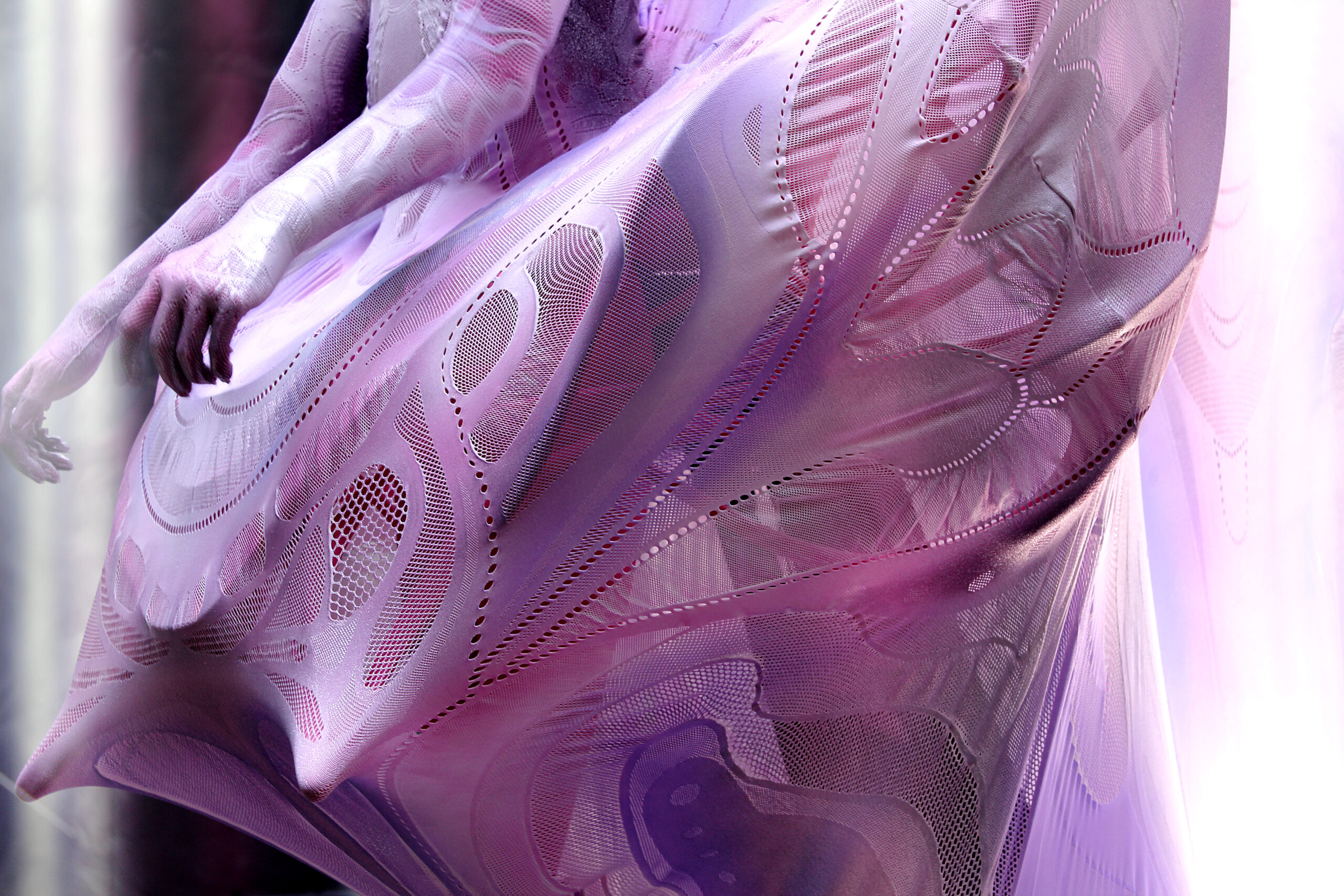
Photo credit: SOMA DESIGN
Challenges Unique to This Pavilion at the Expo
Matsui:
In industrial design, we sometimes present forward-looking concepts based on anticipated technological progress, but usually that means projecting at most about ten years into the future. But this time, we had to imagine a world 1000 years from now, essentially a realm where rational predictions no longer apply. It was challenging because there were no clear “correct answers”; instead, we had to define lofty ideals and believe in them as we created. Still, I think what empowered us to take creative risks was the fact that so many creators were involved in this process of trial and error, and that we had the reassurance of Professor Ishiguro, who took ultimate responsibility as leader.
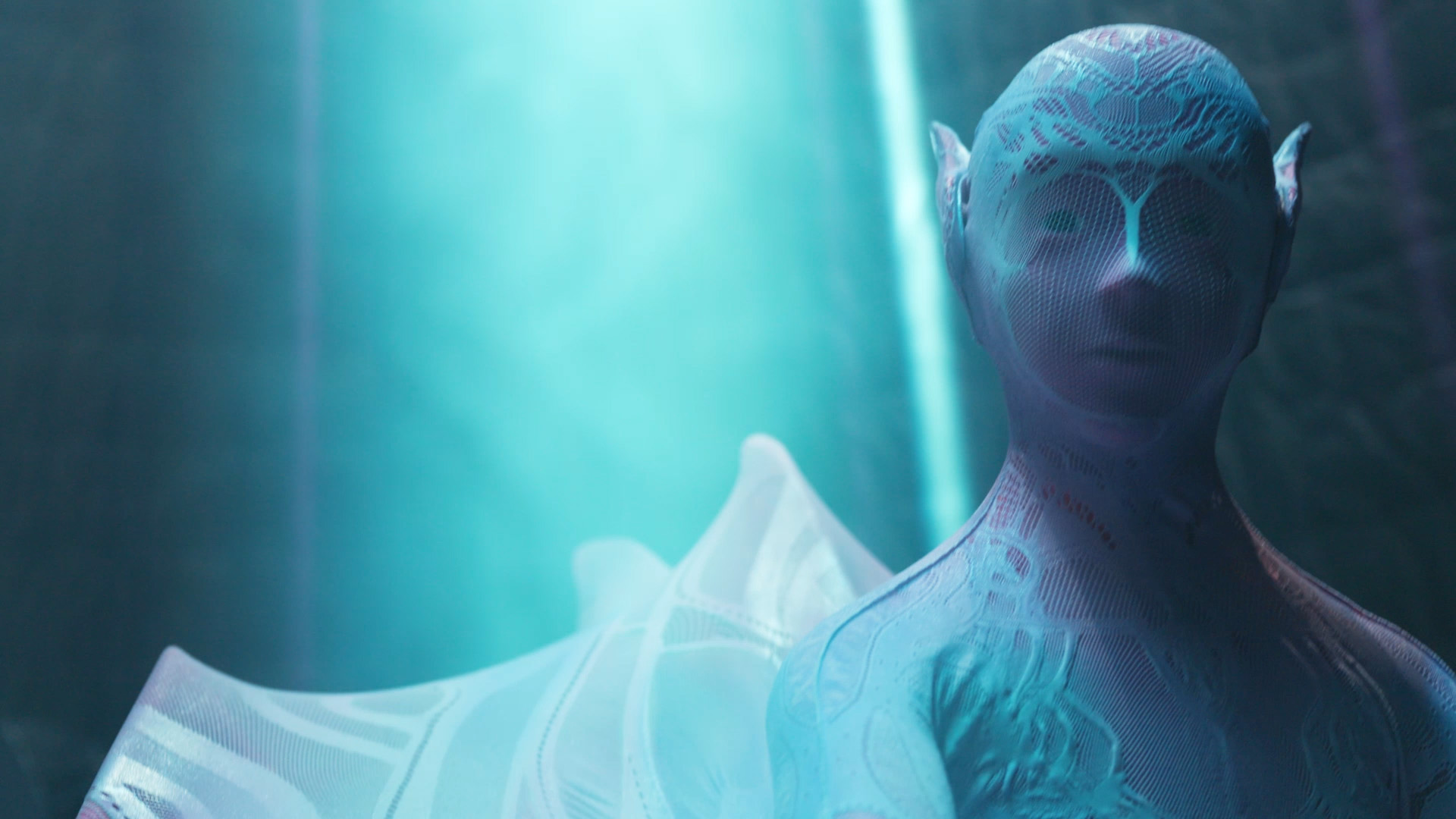
Hirokawa:
I began by designing a structural form that extends each android’s body, an organic expansion of its skeleton and outer skin. This included wearable skeletal parts, such as ear extensions that transform into horns, and a skirt-like exoskeleton with a peach-like shape evoking immortality and referencing the helical structure of DNA at the waist. Over that structure, I planned to dress the androids in seamless knit garments from the Skin Series. But given the complex skeletal design and the fact that, for staging purposes, the androids would rise up to three meters in height, we didn’t know whether the costume could accommodate that movement. Drawing on our past expertise, we developed a design capable of 360-degree stretch. We engineered the structure to withstand significant expansion and contraction, designing each stitch like a living cell, and through painstaking testing with the artisans, we brought it to life.
My vision was that while each android could stand on its own, the three together would move in harmony, forming a unified vortex, a trinity evoking a great Tree of Life. This was an unprecedented challenge not only for us, but also for the artisans involved. Yet thanks to the collective wisdom and skills they brought to the project, we were able to make it a reality. I am deeply grateful to all the artisans who took on this challenge with us and saw it through to completion.
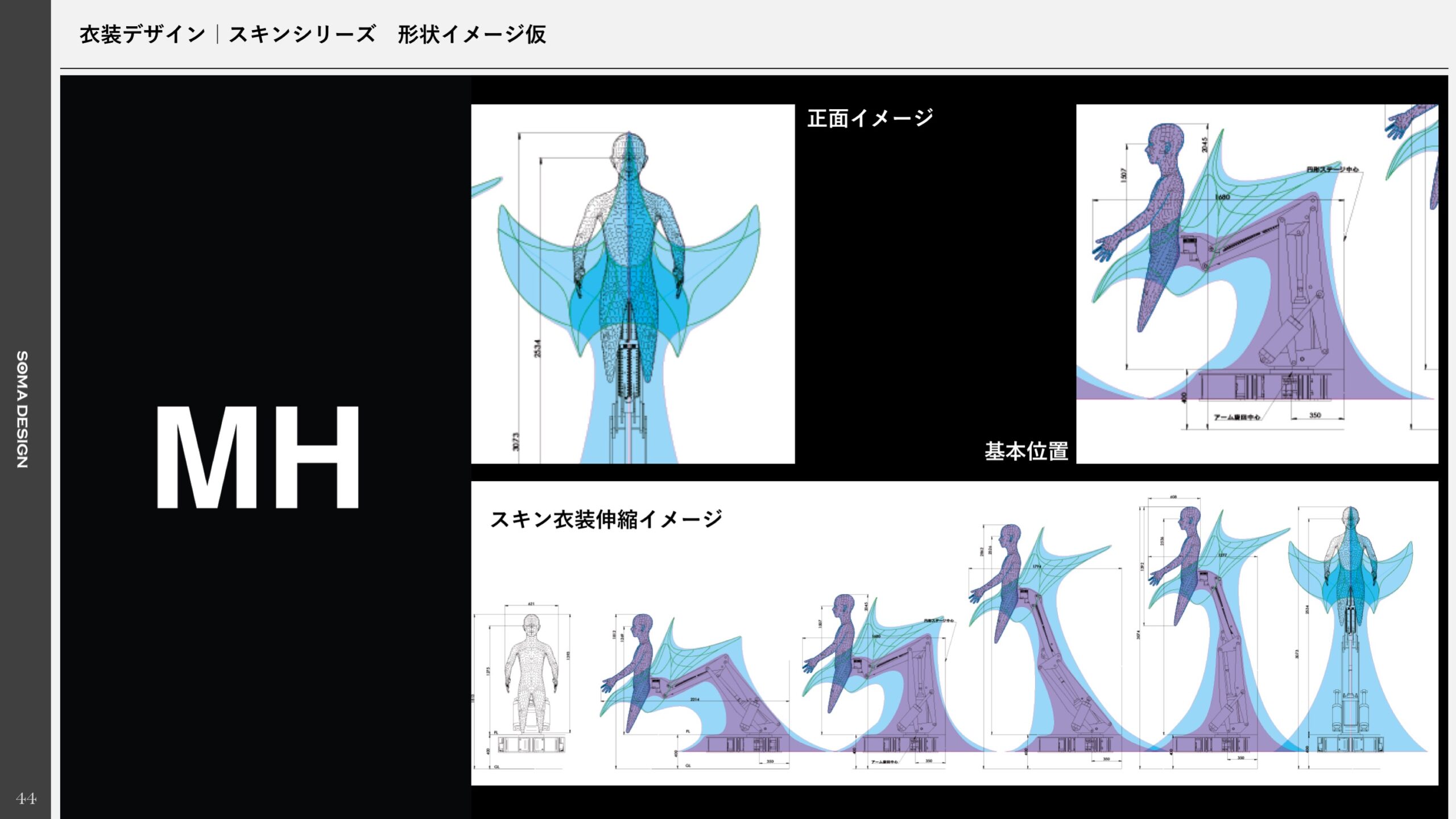
Photo credit: SOMA DESIGN
Lessons learned from the project
Matsui:
In the world of industrial and robot design where I work, our fundamental stance is to think about things in the context of technology and generative AI. But this time, we began with the vision, major goals, and ideals when thinking about the desired shapes, and then we developed whatever technology was missing to realize them, and I feel this reverse approach will be valuable going forward. I also rediscovered the fun of prototyping. By directly giving form to concepts without aiming for commercialization, prototyping has the appeal of allowing us to rediscover the true essence and fun of manufacturing. When a product must function in everyday life, constraints like durability push you toward safe forms, but in prototyping, you can concentrate your energies on the idea itself and take risks. With the emergence of 3D printers and AI, product design is at a turning point as more personal, freer making is becoming possible. In that context, methods that translate a concept faithfully into form will, I believe, lead to new design discoveries.
Hirokawa:
I usually design garments for humans; , but this project asked me to look toward the world 1000 years ahead through a new subject: the android. Collaborating with many professionals of fromwith differing perspectives, including Professor Ishiguro and Matsui-san, gave me many new insights. When a world where robots are part of daily life arrives, we may find ourselves making clothing not only for humans but for robots as well—I feel I glimpsed that possibility. Taking on new techniques was a major challenge in itself, yet it helped us further evolve the skills we’ve cultivated so farover the years, and I believe these skills will surely certainly carry into the future.
Highlights not to be missed
Matsui:
Zone 3 showcases a unified worldview, including the lighting and music of the space. I hope visitors will simply see and feel it, no need to overthink, and come away thinking, “If this future is coming, maybe I wouldn’t mind heading there.” Also, please look closely at the lines on the backs of the MOMO androids—they’re remarkably beautiful. When the three MOMO figures stand together back to back, you’ll surely notice how beautiful it looks.
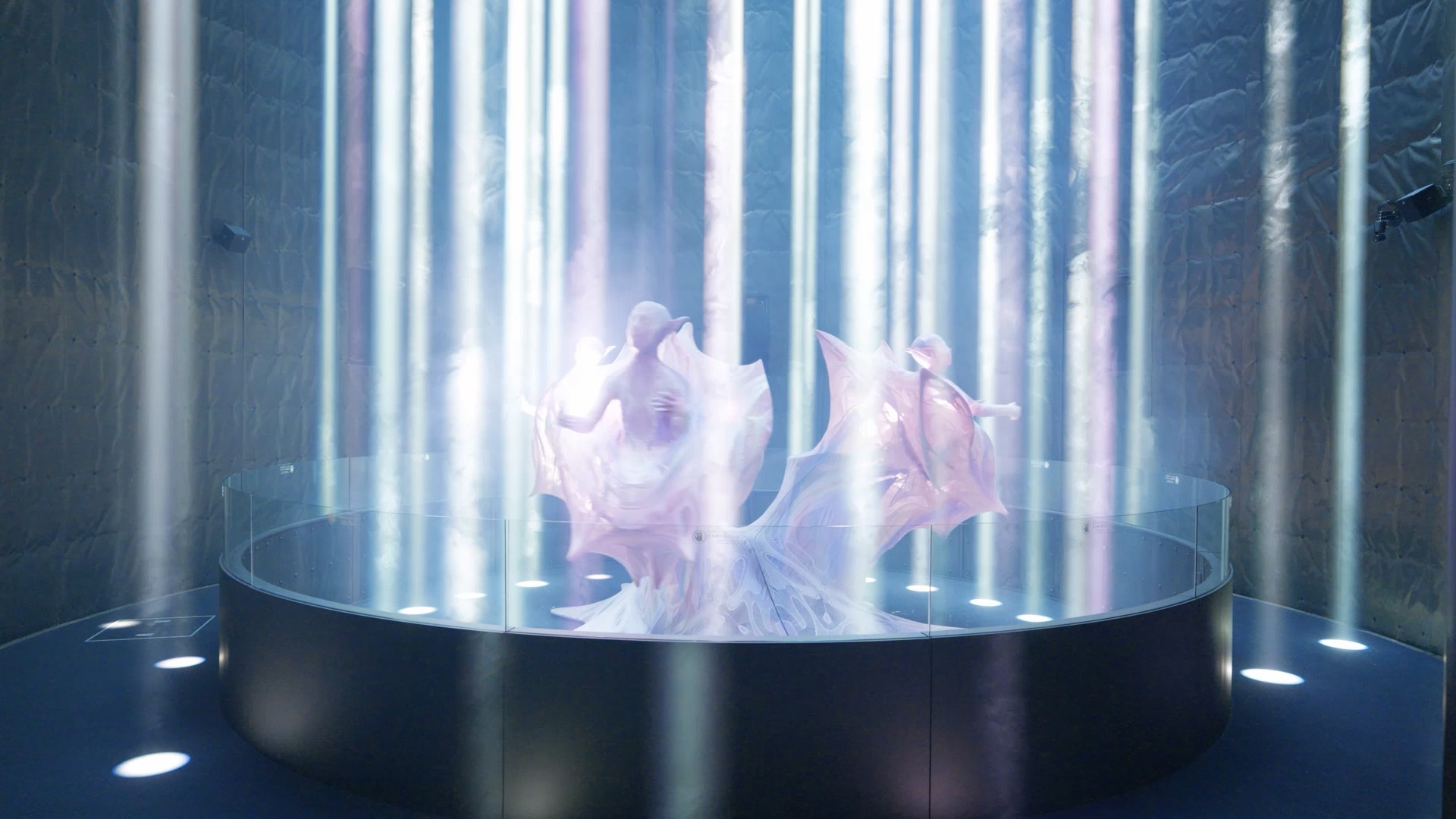
Hirokawa:
The androids express both their individual presence as standalone beings and the micro and macro aspects of ‘being alive’ that emerges when the three entities become one. When looking at a single android on its own, note the beautifully elastic outer skin bearing spiral motifs symbolizing primal life, and the inner skeleton that emerges, translucent, in the light. When the three combine, their spiral patterns overlap to form a single grand shape of life, evoking the elegant form of a DNA helix.
In creating the space of Mahoroba, we applied gradient dyeing to the androids’ skins to express an ambiguous world where the present and the far future intersect. This comes from traditional kimono techniques and embodies the beauty of boundaries, such as twilight, where diverse colors melt into one another. Please come and see our androids, which combine traditional techniques and cutting-edge technology and could only have been brought to life in Japan.
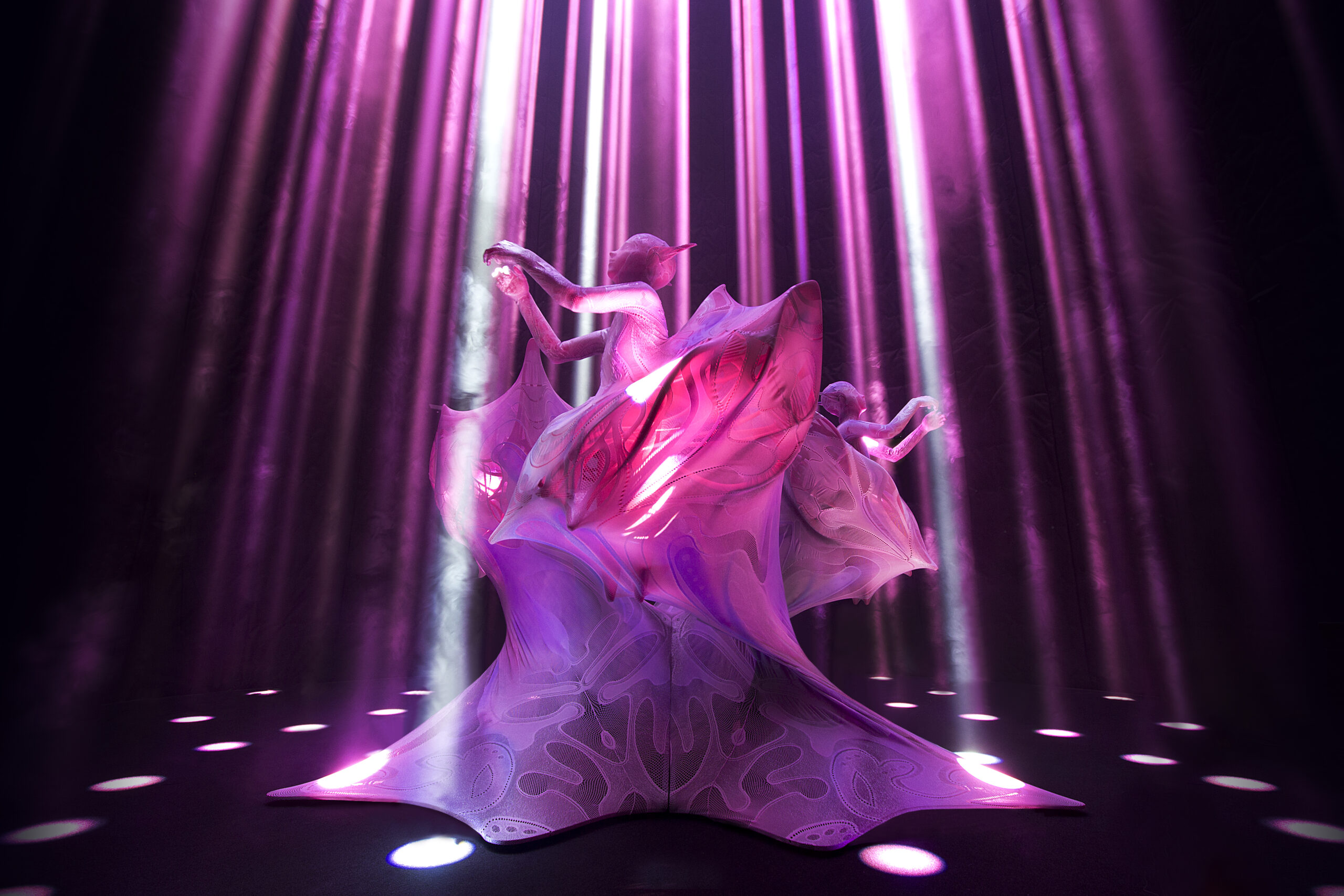
Photo credit: SOMA DESIGN